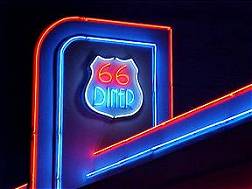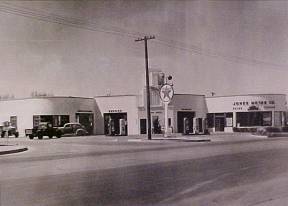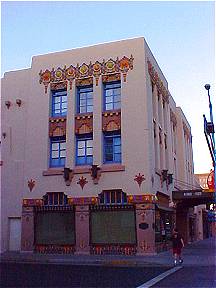|
Albuquerque |
|
[HOME] [WESTERN AMERICANA GALLERY] [ROUTE 66 HOME] [ROUTE 66 WEST] [ROUTE 66 EAST]
|
Albuquerque |
|
Albuquerque, New Mexico is the largest city in New Mexico and owes its explosive growth to the economic boom that Route 66 brought to it during the golden age of the Mother Road. In 1946 Albuquerque had a population of 35,449 and every tourist accommodation possible. |
|
Route 66 through the city is Central Avenue and it is lined with the bright neon lights of any "motel row" of the era. Today the Route 66 visitor can see the architecture of the time periods that Route 66 represents. Motor courts from the 30s and 40s exist side by side with the motels of the 50s, 60s, and 70s. Cafes and old gas stations remind the traveler that he is passing through a city with a rich road history. Albuquerque is an old town too. It was founded in 1706 along the banks of the Rio Grande River. Its old town plaza still speaks to us of its Spanish heritage. In 1881 the Santa Fe Railroad reached Albuquerque. With the coming of Route 66 its economic future was secure. Today both Interstate 40 and Interstate 25 intersect at Albuquerque. | |
|
|
|
The famous El Vado Motel has seen it all! Route 66 passes right in front of this beautiful motor court and its glorious neon has been beckoning travelers for six decades. The adobe cabins epitomize everything southwestern and capture the spirit of the "Land of Enchantment." Because of the El Vado's unique character it has been placed on the National Historic Register. It truly is one of the best examples of a classic Route 66 motor court to be found along the Mother Road and is an irreplaceable treasure indeed! Imagine all the people that have passed through here over the years. |
||
EL VADO ALERT!!!The famous El Vado is in trouble! Apparently it was purchased by a developer who wants to tear it down and build town houses. There will be a public hearing about the developer's request to tear down this historic on-of-a-kind Route 66 icon in Albuquerque on the 20th of October, 2005. Jerry Ueckert of the Edgewood Advocate, a Route 66 Preservationist, will be attending the meeting. Now is the time to show our support for the El Vado. Let Jerry know what your concerns are, maybe we can have our collective voices heard. Join other Route 66 fans by e-mailing Jerry in the support of the El Vado. Just click the handy link below to send your e-mail: "Please let the city officials know that putting up fancy new neon archways that say 'Route 66' is all well and good, but stylish new streetscaping is NOT an acceptable substitute for one of the most famous structures on the Mother Road. Put the townhouses somewhere else. There's absolutely no justification for tearing down a building that is so historically signficant that the Secretary of the Interior has listed it on the National Register of Historic Places and replacing it with the kind of soulless McSubdivisions I can see in any suburb anywhere in the United States." ~ Emily Priddy, Friends of the Mother Road |
||
Albuquerque is proud of its Spanish Colonial heritage as this vintage post card of the Old Town Plaza from the 1950s shows. |
|
|
|
Albuquerque has always depended on its tourist trade. From the many motels, cafes and service stations to the unique southwestern tourist shops, Albuquerque was and still is a mecca in the Rio Grande Valley. Jack Rittenhouse comments in 1946 that "there are many fine shops selling authentic Indian craft goods." He also admonishes the Route 66 visitor to visit the "fine exhibit of Indian antiques assembled by Fred Harvey, in a building adjoining the Santa Fe station." | |
Albuquerque's 66 Diner |
||||
 |
Step back four decades and enjoy the 50s atmosphere of the 66 Diner. You will instantly be taken with the decor and the friendliness of the staff. Tom Willis, the owner and vice president of the New Mexico Route 66 Association, has certainly captured the spirit of the era. | |||
| I quickly found out that their milkshakes are great. I had an orange vanilla mixture that brought back memories of the Dreamsicles I used to buy from the "Popsicle Man" in my youth. The food was very good too. I guess I'll have to list the 66 Diner on my list of great Route 66 eateries. Watch out for the pies too. They are pretty tempting. Any place that has a good rhubarb pie is okay in my book. |
|
|||
The Old Jones Motor Company |
||||
 |
In 1939 Ralph Jones had his new Ford dealership built in the new Streamline Moderne style, his building became one of the most modern facilities in the west at that time. The large curved front window allowed passing motorists a view the latest Ford automobiles. His motor company included a full service gas station. Built at the then eastern end of Albuquerque, his service station was one of the first encountered by west bound travelers. Location was everything! For the travelers with heavy loads Ralph put a canopy in the back so they could unload their cars in the shade before being worked on. | |||
| Jones Motor Company thrived on this corner of Route 66 for almost twenty years. In 1957 Jones Motor Company moved to a new location. The building became home to many businesses the next forty years from a moped shop to an army surplus store. In 1993 it was officially designated as a historic building. Janice and Dennis Bonfantine bought the old Jones Motor Company in 1999 and fell in love with the old building. They had plans for it too. Through their dedication to historic preservation they brought the Jones Motor Company building back to life for others to enjoy as Kellys Brewery. They gave a new generation of Route 66 travelers a glimpse of what life was like back on the Mother Road sixty years ago. |
|
|||
Route 66 Side Trip to Central Avenue Neons: |
Historic Kimo Theater |
||||
 |
The KiMo Theater is a beautiful example of the Southwestern themed architecture known as Pueblo Deco. Pueblo Deco was a short-lived style that brought together the spirit of the Southwestern Indian cultures and the optimism of America during the roaring twenties. The KiMo was built in 1927 right on Route 66 and it is now listed on the National Register of Historic Places. The interior of the KiMo Theater is resplendent with ornate sculptures depicting the important Native American influence on the area. Indian signs and symbols grace every nook and cranny. The KiMo houses a beautiful mural "The Seven Cities of Cibola" painted by noted southwestern artist Carl von Hassler. It was a true palace and showplace in its day but the KiMo fell into disrepair following the the mass exodus to the suberbs that so many cities have experienced. It was slated for destruction in 1977 when citizens of Alburquerque voted to purchase this great movie palace. The city of Albuquerque bought the building and restored it to its original glory. I've never seen anything quite like it. It is beautiful, but so very different from the Los Angeles movie theater on Route 66 at 7th and Broadway in L.A. The KiMo is truly a treasure of the southwest. | |||
| Many visitors to the KiMo Theater are shocked and even offended by the prominent use of the swastika symbol throughout the theater's motif. A word of explanation is in order. Today, unfortunately, the swastika has come to symbolize a terrible time in human history. It is instantly identifiable with Hitler and Nazi Germany, the holocaust and a world war. That was not always the case though. In fact the swastika symbol goes back thousands of years and has been used by most of the world's cultures in one form or the other. It has been used as a symbol for peace, life and harmony. The swastika is an important symbol to the Native Americans of the southwest, it is found in their pottery, weaving, and can even be found on rock art dating back thousands of years. To the Navajo the swastika is a symbol for balance and happiness and the Hopi Indians use it to represent the four directions of the wind. Until Hitler corrupted its meaning it has always been associated with the good. At the time the KiMo was built in 1927 it was a perfectly acceptable and wonderful symbol. |
|
|||
Photographs Taken September 2002
Click on an area or city of Route 66 on the map below to take a cyber tour of that section of the Mother Road |
| NAVIGATION NOTE: Buckle up and hold on to your mouse! These pages are arranged like the map above, from the western state border to the eastern state border. I have set up this site as if you were traveling from EAST to WEST, much like the Joad family in The Grapes of Wrath. You can click on the Route 66 shields to "travel" the Mother Road in either direction though. Or you can select any shield below to take you to that specific state. | ||
To Laguna Area |
To Clines Corners |
© Copyright 2003 GRandall Web Design Service